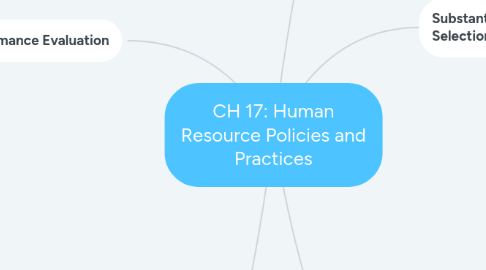
1. Selection Practices
1.1. initial selection.
1.1.1. application forms.
1.1.2. background checks.
2. Substantive and Contingent Selection
2.1. written tests.
2.1.1. intelligence or cognitive ability tests.
2.1.2. personality test.
2.1.3. integrity tests.
2.2. performance-simulation tests.
2.2.1. work sample test: hands-on simulations of part or all the work that applicants for routine jobs must perform.
2.2.2. assessment centers: off-site places where candidates are given a set of performance-simulation test design to evaluate their managerial potential.
2.2.3. situational judgement tests: ask applicants how they would perform in a variety of job situations; the answers are then compared to the answers of high-performing employees.
2.2.4. realistic job previews: jobs tryouts to assess experience versus talent.
2.3. interviews.
2.3.1. unstructured interview: short, casual interviews made up of random questions.
2.3.2. structured interviews: planned interviews designed to gather job-related information.
2.3.3. panel interviews: structured interviews conducted with a candidate and a number of panel members in a joint meeting.
2.4. contingent selection tests.
3. Training and Development Programs
3.1. types of training.
3.1.1. basic skills.
3.1.2. technical skills.
3.1.3. problem-solving skills.
3.1.4. interpersonal skills.
3.1.5. civility training.
3.1.6. ethics training.
3.2. training methods.
3.2.1. job training.
3.2.2. computer-based training.
3.3. evaluation effectiveness.
4. Performance Evaluation
4.1. task performance: the combination of effectiveness and efficiency at doing your core job tasks.
4.2. citizenship: actions that contribute to the psychological environment of the organization, such as helping others when not required.
4.3. counterproductivity: actions that actively damage the organization, including stealing, behaving aggressive toward coworkers, or being late or absent.
4.4. what do we evaluate?
4.4.1. individual task outcomes.
4.4.2. behaviors.
4.4.3. traits.
4.4.4. traits.
4.5. methods of performance evaluation.
4.5.1. written essays.
4.5.2. critical incidents: a way of evaluating the behaviors that are key in making the difference between executing a job effective and executing it ineffectively.
4.5.3. graphic rating scales: an evaluation method in which the evaluator rates performance factors on an incremental scale.
4.5.4. behaviorally anchored rating scales (BARS): scales that combine major elements from the critical incidents and graphic rating scale approaches.
4.5.5. forced comparison: method of performance evaluation where an employee's performance is made in explicit comparison to others.
4.5.5.1. group order ranking: places employee into a particular classification, such as quartiles.
4.5.5.2. individual ranking:
4.6. improving performance evaluations.
4.6.1. use multiple evaluators.
4.6.2. evaluate selectively.
4.6.3. train evaluators.
4.6.4. provide employees with due process.

